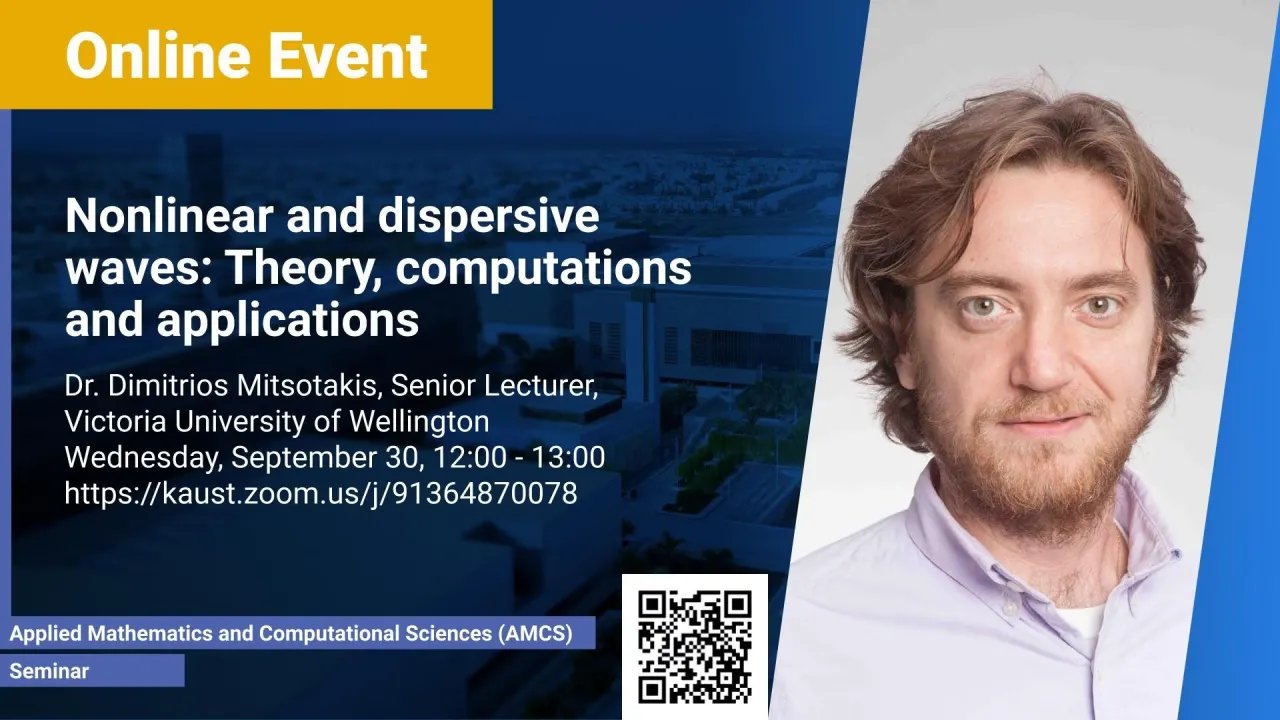
Nonlinear and dispersive waves: Theory, computations and applications
- Dr. Dimitrios Mitsotakis, Senior Lecturer, Victoria University of Wellington
KAUST
The study of waves in fluids is one of the most significant branches of fluid mechanics. Part of this study is the theory of nonlinear and dispersive waves which has recently emerged and is still under development. Nonlinear and dispersive waves appear in fluids of any form and have significant role in the fields of oceanic waves (surface and internal), atmospheric modelling, electromagnetism, nonlinear optics, ultra-cold matter and even in blood flow problems. In this presentation we will review relevant applications, such as tsunami waves, the El Nino southern oscillation, blood flow in arteries and solitons propagating in optical fibres. Mathematical modelling techniques for deriving equations that describe such phenomena will be introduced in the context of surface water waves. We will also review the minimum required theoretical background in order to proceed with safe numerical simulations. Finally, we will discuss the numerical modelling of such problems where methods such as standard and mixed Galerkin / Finite element methods are of central focus. We close this presentation by showcasing a topic of much current interest, namely, the development of modern mathematical models for nonlinear and dispersive waves by combining machine learning techniques with classical methodologies.
Overview
Abstract
The study of waves in fluids is one of the most significant branches of fluid mechanics. Part of this study is the theory of nonlinear and dispersive waves which has recently emerged and is still under development. Nonlinear and dispersive waves appear in fluids of any form and have significant role in the fields of oceanic waves (surface and internal), atmospheric modelling, electromagnetism, nonlinear optics, ultra-cold matter and even in blood flow problems. In this presentation we will review relevant applications, such as tsunami waves, the El Nino southern oscillation, blood flow in arteries and solitons propagating in optical fibres. Mathematical modelling techniques for deriving equations that describe such phenomena will be introduced in the context of surface water waves. We will also review the minimum required theoretical background in order to proceed with safe numerical simulations. Finally, we will discuss the numerical modelling of such problems where methods such as standard and mixed Galerkin / Finite element methods are of central focus. We close this presentation by showcasing a topic of much current interest, namely, the development of modern mathematical models for nonlinear and dispersive waves by combining machine learning techniques with classical methodologies.
Brief Biography
Dimitrios Mitsotakis is a Mathematician and expert in the theory of water waves and in the numerical analysis of Partial Differential Equations. He develops numerical methods for the solution of models for water waves and he studies real-world applications such as the generation of tsunamis. Some of his main contributions are in the theory of Boussinesq systems for nonlinear and dispersive water waves. He has also developed numerical models for the simulation of the generation and propagation of tsunami waves and the dispersive run-up. He studied the convergence and error estimates of several Finite Element Methods for various nonlinear and dispersive wave equations. He is interested in interfacial water waves and waves in superfluids and in blood flow problems. Numerical methods of preference are Finite Element, Spectral, Finite Volume and Discontinuous Galerkin methods.
Dimitrios received his batchelor's degree from the University of Crete with the highest honours (first in class) in 2000. He received a master’s degree in Applied and Numerical Analysis in 2003 and a PhD in Mathematics in 2007 from the University of Athens. His experience with high performance computing started while a visiting student at the Edinburgh Parallel Computing Center at The University of Edinburgh in 2000. Dimitrios worked at the Université Paris-Sud (2008-2010) as a Marie Curie researcher, at the University of Minnesota (2010-2012) as an associate postdoc and at the University of California, Merced (2012-2014) as a visiting Assistant Professor. Since 2014 Dimitrios works at Victoria University of Wellington and is currently a Senior Lecturer at the School of Mathematics and Statistics.
